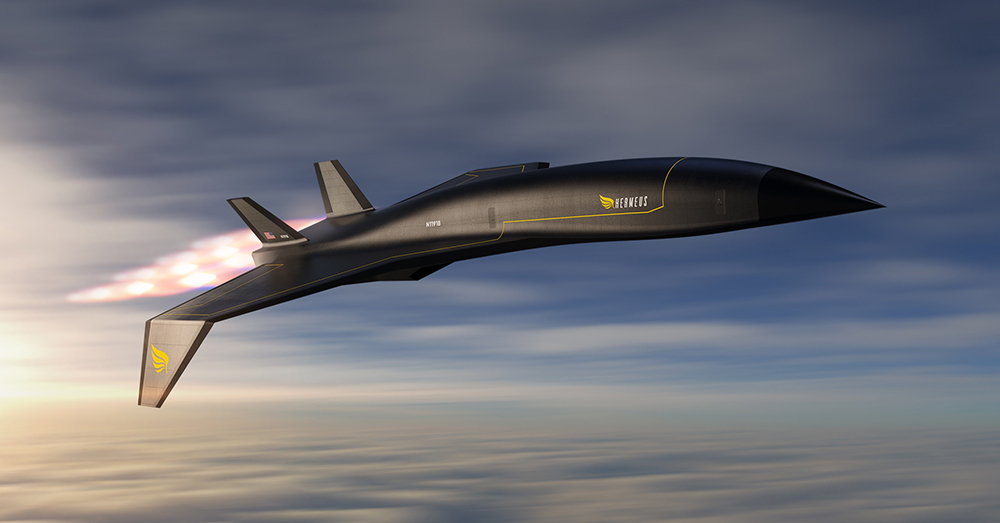Almost 2 decades after the Concorde passenger plane, which went 2 times faster than sound, ceased service, interest in using supersonic aircraft in the travel industry has increased, and many high-speed aircraft are being developed. Airlines are interested in operating supersonic passenger planes, and United Airlines is already implementing supersonic flights in 2029 at the earliest. If passenger planes could actually fly 5 times faster than sound, it would take just 90 minutes to travel between New York and London, which normally takes between 6 and 7 hours. The Atlanta-based company Hermeus believes it will be able to operate supersonic flights and is testing a new type of engine that can go 5 times faster than sound (Mach 5 – over 3,000 miles per hour).
The new type of engine created by the Hermeus company is being produced for the U.S. Air Force, aimed at a small supersonic unmanned vehicle. If the new engine is made larger, it can be used in passenger planes. But since the technology has to be prepared and created from scratch, it will take a Fri time to fly supersonic passenger planes. The Hermeus company hopes to make its first test flight in 2029 before the end of this decade. Initially, the Hermeus company’s aircraft will be much smaller than current passenger planes and even smaller than Concorde planes. Concorde planes can carry around 100 passengers. “If you want to help us, tell us what size plane we should build to make a model that will be able to operate on an airline. Focused on businessmen and first class passengers.
After that, the factors such as speed and fare will be calculated. “We will build a plane that can carry 20 passengers,” said Hermeus Company CEO AJ Pyinplika. The Hermeus company’s plane can fly up to 4,000 nautical miles, so it can cross the Atlantic Ocean from New York to Paris, but not the Los Angeles-Tokyo route that has to cross the Pacific Ocean. noise limit; Because of the regulations, the supersonic plane will only be allowed to fly over water and not fly on the New York – Los Angeles route, which would have to go over land. The fastest vehicle in the world is NASA’s X-43A unmanned vehicle, which travels 9.6 times the speed of sound (6,800 mph). The 12-foot long vehicle was flown in 2004. But that vehicle only flew for a few seconds. The Boeing X-51 aircraft that flew at 5 times the speed of sound for the longest time flew for more than 3 minutes in 2013. Both of these vehicles were loaded onto B-52 bombers and then flown. It had to be accelerated with a rocket to make it supersonic. This clearly shows the complexity of high-speed flights. The record for the highest speed among manned vehicles is the X-15, which was flown in 1967.

In fact, the X-15 vehicle cannot be called a plane, but a model with a seat on a rocket, and was created with the aim of setting a record. The vehicle was also flown by a B-52 bomber. The SR-71 Blackbird, a military spy plane that flew in 1976, was able to set a record for flying without a rocket or an engine. Of the two supersonic passenger airliners ever to fly commercially, Concorde’s top speed was 2.04 times the speed of sound (1,350 miles per hour). The passenger plane being built by Hermeus has broken the record for the fastest jet-powered plane by a wide margin and can fly up to 5 times the speed of sound. The Hermeus company’s initial focus was on aircraft engines. fighter jets The design of a new type of engine, based on the types of engines used in airplanes produced by General Electric, has been tested since February 2020. The new type of engine will combine 2 common technologies. The turbo jet engine used in airlines will be combined with a ramjet engine (which operates at speeds faster than sound). Initially, the engine will be used in the Quarterhorse unmanned vehicle.
Hermeus is developing the Quarterhorse unmanned vehicle in partnership with the US Air Force as part of a $60 million project. What’s interesting is that in designing a jet engine to go faster, parts are removed rather than added. In a turbo engine, air enters from the front and compresses the air, creating energy when the vanes rotate and burning when it comes in contact with the fuel. Blowing hot gases out the back of the engine causes the plane to move eastward. But at 3 times the speed of sound, there is no need to pressurize the air. As soon as the air enters the engine, it is already pressurizing itself when the speed is reduced. Ramjet engine types are called ramjets, from 3 times the speed of sound to 5 times the speed of sound. A ramjet engine has no moving parts like a turbojet. But the engine does not work below 3 times the speed of sound. The Hermeus company launched a supersonic plane. A turbojet engine will be used when landing. In flight, a ramjet engine will be used at 3 to 5 times the speed of sound. But the Hermeus company still has a lot of problems to solve, and because the fuel consumption is too high, we have to think about what kind of fuel to use in the long run. We also have to solve the problem of the fuel tank temperature being too high in supersonic aircraft. The SR-71 Blackbird used a titanium fuel tank to cope with extreme temperatures. The Hermeus company also needs a lot of funding. But SpaceX’s Falcon 1 Dragon The Hermeus company said they will raise funds for the supersonic passenger plane project while building airplanes, just as they raised funds while building the Falcon Heavy and Starship rockets.




